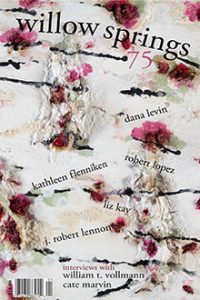
About Lucas Southworth
Lucas Southworth’s stories are forthcoming from or have recently appeared in TriQuarterly, Mid-American Review, Hayden’s Ferry Review, Web Conjunctions, DIAGRAM, Meridian, and others. His collection of short stories, Everyone Here Has a Gun, was the winner of AWP’s Grace Paley Prize in 2012, and University of Massachusetts Press published the book in late 2013. He is also a professor of fiction and screenwriting at Loyola University Maryland and a co-partner at Slash Pine Press. Links to info on Everyone Here Has a Gun and other online work can be found at everyoneherehasagun.blogspot.com.
A Profile of the Author
Notes on “Copycats”
I wouldn’t describe writing as fun. I wouldn’t describe my stories as fun. But I enjoy writing when I’m doing it, and it’s probably the only time I can relax deep into my head where I’d spend all my time if the world would let me (thank you, world, for not letting me). For me, fiction is a way of extracting ideas from feelings and then twisting those ideas back to feelings. Feeling is probably a bad word for it, but I can’t think of a better one. What I’m referring to falls somewhere between sense and emotion and that thing that nags us, but it’s also pure and real and something that longs to be understood. My favorite writing by other authors falls willingly and unconsciously and sometimes effortlessly into that canyon between thought and feelings. As a writer, I constantly struggle with the divide. I think my work often documents that struggle as I strive, and usually fail, to push it over that edge.
“Copycats” contains an actual jump, an actual fall. It happened to an actual man who actually bought a plane ticket for an actual fake name. My version of the story started with a friend’s fascination. As we sat in a bar or maybe a steamy pho restaurant in the middle of winter, he explained what he knew about D.B. Cooper. I already felt removed, and I liked that feeling. I liked how the story was coming secondhand, and I liked how everything was actual and false at the same time. It wasn’t my story exactly, or my obsession, so I approached it with that skepticism and remove. I started with the disappearance and with those, like my friend, who connected with the disappearance—an actual that wasn’t actually there. I was drawn as much to Cooper’s copycats as I was to Cooper. Some were simply hijackers that came after, but the strangest were those that “confessed” to be him, often as a final, dramatic gesture on their deathbeds. One was even a woman who claimed she’d had a sex-change operation to conceal her/himself.
From what I could find, none of these people ever “proved” to be Cooper, and it struck me that if we were never going to reveal the actual hijacker or allow him to reveal himself, we were going to fill in his absence any way we could. In fact, maybe we preferred that. I wondered what caused these copycats to confess something that wasn’t theirs to confess. Why had they tried to take Cooper’s place? Why did they want to help him reappear? These questions didn’t have logical answers, probably, which is why I liked them so much. By the time I finished writing “Copycats,” I’d decided that Cooper had always set out to disappear. He must have known he could not spend the money, and he must have suspected that if he succeeded, nobody would ever see him again. If this thought was freeing for him before the hijacking, I wondered if that changed afterward. I imagined a diner—a timeless, American type of place—where all these copycats, all these different versions of Cooper, could meet. If they did, would some still be proud of what they’d done? Would some be filled with regret? And how much had they really disappeared over time? Would they allow themselves to recognize each other? Would they want others to recognize them? All this started as a feeling more than any kind of thought. I tried to form that feeling into something and then go back again.
Though I may not have had fun writing, Cooper was certainly a fun subject. He provided a mystery that couldn’t be solved, gaps that couldn’t be filled. I also couldn’t help but notice how as the writer of my version of his story, I was assuming the role of another copycat, and how readers would be doing the same. The decision to use second person came from that—from the image of more and more copycats rippling out from the center of the story.
Notes on Reading
I’ve been seeking out authors that are able to effortlessly bridge between thought and that indefinable feeling that I think is hinted at in the best fiction. Right now I’m reading the complete stories of Flannery O’Connor cover to cover. I love the way her messy moments and digressions are her most fascinating, and how somehow those moments still fit within the larger and unconscious logic of the story. I just read Miss Lonelyhearts and The Day of the Locust by Nathaniel West too, and I think he’s able to find that space as well. On the absolute flipside, I’ve been teaching screenwriting and film this semester and thinking about classical story form. I’ve also been thinking about how elements of film must inform modern fiction, how those elements have become embedded in our story-telling consciousnesses, and how we can continue to learn from those strategies and use them. Critics have disputed this analogy, but I find it interesting think about, for example, how editing transfers to our use and understanding of the sentence, or how the framing of vertical, horizontal, and diagonal lines can work into my own descriptions and settings.


